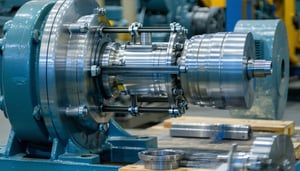
Pump Misalignment
Proper alignment of a pump shaft with the driver can reduce vibration and significantly improve its reliability.
However, if a pump is misaligned to its driver, then you can expect vibration to dramatically increase, resulting in damage to bearings and the seal – ultimately the pump will fail, leaving you with a costly repair bill!
Misalignment
With energy efficiency and cost efficiency becoming two of the most important factors when building a new piping system and selecting a pump for the operation, minimizing equipment downtime has become increasing important. Misalignment can cause costly downtime.
The lack of alignment is a problem where the rotation centerlines of two or more machinery parts are not in line with each other. Unfortunately, this is sometimes undetectable, depending of the severity of the misalignment. And since some vibration is perfectly normal for pumps, it is best to have an experience vibration technician to determine if the vibration is due to the shaft misalignment and whether or not is it severe enough to have already caused damage to your pump.
Other effects of misalignment include:
- Bearing life of the pump and driver can dramatically reduce, causing high temperatures or oil leakage.
- Mechanical seal failure due to the mechanical seal not handling the misalignment
- Shaft failure or breakage can occur if the equipment is severely misaligned
- Severe misalignment can cause the most durable and best designed couplings to wear quickly or even fail!
- Vibration can cause different parts to operate with excessive noise or grinding.
- Additional [and sometimes excessive] power consumption
- Damage to the coupling inside
Not to worry though! Misalignment problems are relatively easy to solve!
Three Types of Alignment
There are three different types of alignment measurements.
- Parallel – Where the pump and the motor shaft centerlines are not concentric to each other
- Angular – Where the shafts are not parallel to one another
- Axial – The axial dimension is the distance between the coupler flanges
Methods of Alignment
There are three basic methods of alignment.
- Straight edge – With a taper guage, feeler gauge or caliper
- Dial Indicator
- Laser
Which to use and when?
… It depends on how critical the alignment is. The main factor that determines the critical nature of an alignment is shaft speed. The greater the shaft speed, the more critical the alignment becomes. Therefore, less accurate methods of alignment can be used at a slower shaft speed.

Straight Edge and Taper
A typical centrifugal chemical pump might have an application that requires a 1,800 rpm. Alignment is important, but a less accurate method can be used here.
Therefore the Straight Edge method would be appropriate (Figure 1).
The straight edge method is largely simple method of alignment, it requires no special tool or training, just a keen eye and it is relatively quick.
Simply lay the straight edge across the coupler halves at the top, bottom, right and left to measure the parallel dimensions. Next, insert the taper gauge between the coupler halves to measure the angular misalignment.
We often post articles and other news on our LinkedIn page. Go and follow to keep up to date, or for any pump queries you may have please contact us.






